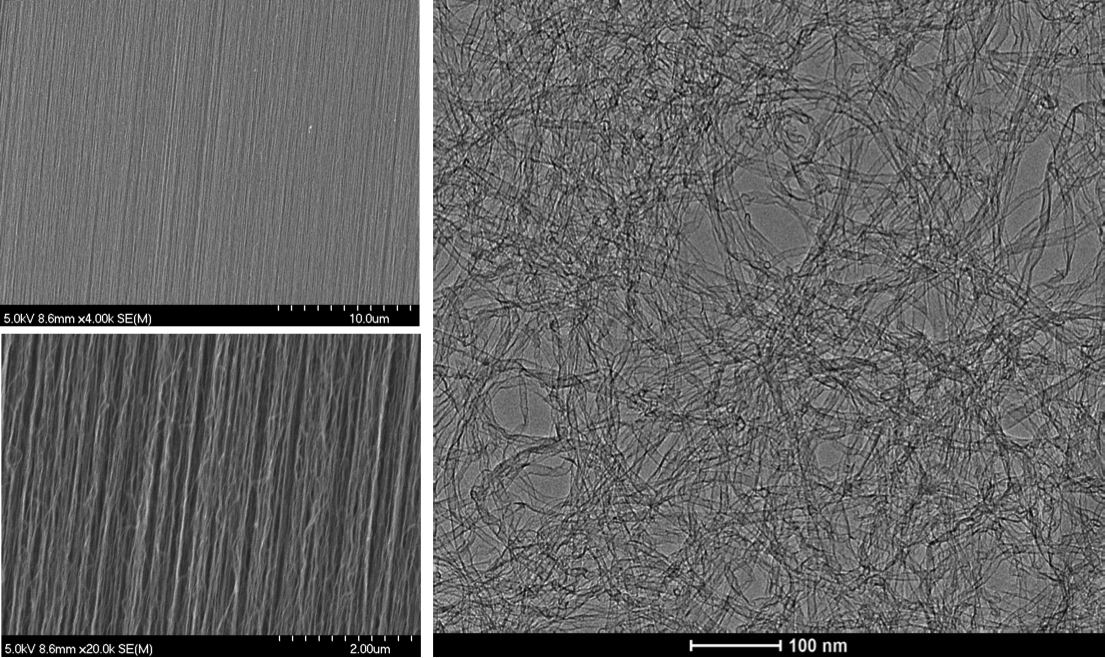Szolgáltatás
Párhuzamosan irányított ultrahosszú szén nanocső szőnyegek szintézise / Synthesis of vertically aligned carbon nanotube forests
KUTATÓK
TUDOMÁNYÁGAK
SZOLGÁLTATÁST NYÚJTÓ KUTATÓMŰHELY
SZOLGÁLTATÁS LEÍRÁSA
Properties:
Diameter of tubes: 9-14 nm
Number of walls: 2-6 pcs
Density of forest: ~10^12 tubes/cm2
Height of forest: can be choosed between 300um-1500um
Area of forest: 5x5mm, or 10x10mm
KAPCSOLAT
REFERENCIÁK
ABSTRACT
Efficient and reproducible growth of vertically aligned carbon nanotube (CNT) forests by catalytic chemical vapor deposition (CVD) requires precise setting of the properties of the catalyst thin films and CVD con- ditions. In this work, super growth of vertically aligned CNTs onto Al2O3 support and Fe–Co catalyst layer system is presented. The layers were grown by pulsed laser deposition (PLD) onto silicon wafer pieces. Their thickness and optical properties were controlled by spectroscopic ellipsometry. The effect of heat treatment at 750 °C in nitrogen and in hydrogen of these PLD layers was com- pared. High-resolution electron microscopic images showed that treatment of catalyst layers in H2 resulted in finer and denser catalytic particles. As a result, well- aligned, dense and few-walled CNT forests with 1–1.5 mm height were deposited by water-vapor-assisted CVD on the hydrogen-treated films, while without hydrogen treatment defected CNT structures were grown. According to these observations, Raman spectroscopy showed a higher degree of crystallinity in case of CNT-s, where reduction by hydrogen influenced the oxidation state of the metallic catalytic particles in a beneficial way.
ABSTRACT
Hybrid assemblies based on conducting polymers and carbon nanomaterials with organized nanoscale structure are excellent candidates for various application schemes ranging from thermal management to electrochemical energy conversion and storage. In the case of macroscopic samples, however, precise control of the nanoscale structure has remained a major challenge to be solved for the scientific community. In this study we demonstrate possible routes to homogeneously infiltrate poly(3-hexylthiophene), poly(3,4-ethylenedioxythiophene), and polyaniline into macroscopic arrays of vertically aligned multiwalled carbon nanotubes (MWCNTAs). Electron microscopic images and Raman spectroscopic analysis (performed along the longitudinal dimension of the hybrid samples) both confirmed that optimization of the electropolymerization circumstances allowed fine tuning of the hybrid structure towards the targeted application. In this vein, three different application avenues were tested. The remarkable anisotropy in both the electrical and thermal conductivity of the nanocomposites makes them eminently attractive candidates to be deployed in thermal management. Thermoelectric studies, aimed to understand the effect of organized nanoscale morphology on the important parameters (Seebeck coefficient, electrical-, and thermal conductivity) compared to their non-organized hybrid counterparts. Finally, extraordinary high charge storage capacity values were registered for the MWCNTA/PANI hybrids (500 F g−1 and 1–3 F cm−2). © 2015 Wiley Periodicals, Inc. J. Polym. Sci., Part B: Polym. Phys. 2015, 53, 1507–1518

